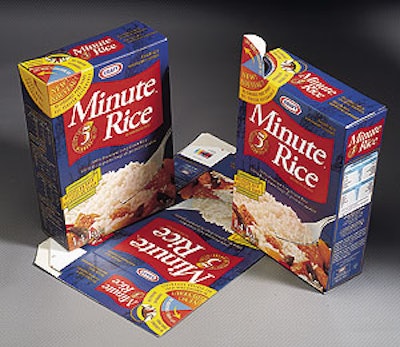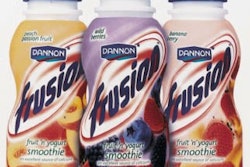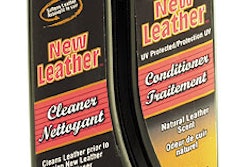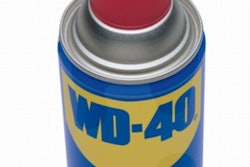
An integral corner pour spout built into a paperboard package for uncooked rice has just been awarded a patent from the U.S. Patent and Trademark Office, according to Somerville Packaging (Montreal, Quebec, Canada). The first user of the package is Kraft Canada for its Minute Rice in both 700-g and 1.4-kg boxes.
The patent was awarded to John Zimmermann, product development manager, who is a 40-year Somerville veteran. It’s the 32nd patent Zimmermann has received, including those granted in the United States and in Canada.
The Kraft rice package was first introduced about 18 months ago, according to a Kraft Canada packaging executive who did not want to be identified. Previously, Minute Rice in Canada was packed into paperboard boxes without a pour spout. In the United States, Minute Rice comes in a box with a metal side-pour spout from a different vendor, the Kraft Canada executive tells Packaging World.
What makes the Kraft Canada package so unusual is that the spout is located in a corner of the box so the entire contents can be easily poured out. Designs incorporating spouts on the side usually trap product in the corners of the box and require the consumer to open glued flaps to discharge all of the product.
In addition, because the paperboard spout is an integral part of the package, it eliminates the need to have a converter inventory a separate metal or plastic spout, and to operate the equipment to insert the spout into the paperboard blank in a separate process. By eliminating these steps, the resulting package is more efficient to produce and more economical for customers like Kraft Canada.
“The beauty of this project,” says Jim Hughes, manager of materials procurement for Kraft Canada, “is that there is no upcharge for this added feature. We felt it was a distinct advantage that we didn’t have to make any pricing adjustments to offer the consumer this added convenience.”
Synergy with equipment
In the end, says Zimmermann, the new spout design fit Kraft Canada perfectly.
Somerville already had a paperboard pour spout design that had been patented in 1990. However, Kraft Canada was less than enthusiastic about it. “We didn’t like the earlier design,” says Hughes, “because it had some exposed edges that we didn’t think consumers would like.” There were also some performance issues with that design, according to the packaging official.
While the company was working to develop a design that would meet the customer’s needs, Kraft Canada had installed some new equipment for packaging the rice, although the company declined to elaborate. “When we came up with the revised spout design, we found the new equipment was much more suitable for producing the package than the packaging machines they had used before,” says Zimmermann. He calls it a “lucky accident.”
One key to Kraft’s adoption of the new package is the reclosure feature that is part of the patent. After opening, the spout is folded closed, using a friction-fit reclosing feature, according to the packaging executive at Kraft Canada. Somerville’s Zimmermann calls it a “snap-fit.” When the spout is folded flat, he says, it snaps under a tab in the flat top of the package.
In-line process
Somerville makes Kraft Canada’s Minute Rice boxes from 26-pt clay-coated newsback that’s printed flexo in seven colors. What makes the new feature so economical is that the spout feature is added via rotary die cutting immediately after the board has been printed in the flexo press. Zimmermann claims there’s nothing terribly unusual about the dies, but he does say that the die cutting has to be very precise.
“We originally did our tests on reciprocating presses with platen dies to prove out the performance of the spout,” he says. Once the customer was convinced the spout would work to satisfaction, Somerville invested in the more costly rotary dies, which Zimmermann estimates at C$80ꯠ (or about US$52ꯠ). He says just 10 to 15% of the dies are dedicated to creating the pour spout.
“Sure, there’s a bit more care and monitoring that needs to be done to create the spout properly. There are increased levels of intricacies in the die cutting for this package,” he admits. “But once you have the die made, the pour spout essentially adds no more cost to the package.”
In an aside, Zimmermann says that Somerville has also applied for a Canadian patent on the package, but it hasn’t been issued yet. “We used to apply for the patents in Canada first. Then when it was issued, we’d apply in the United States. We’ve found that the approvals are faster in the U.S., so now we start there. The U.S. patent office seems to be better organized than the one here in Canada,” he says candidly.
Excellent reception
After marketing the Minute Rice in these packages for more than a year, Kraft Canada says the spout feature has been well received.
“We’ve had strong feedback from consumers through our 800 telephone number for Kraft in Canada,” Hughes reports. “The consumers really like the ease of opening and reclosing the package. It gives our package a distinct advantage in the marketplace.”
Hughes also commends Somerville for the development of the new spout design. “We think this version is a major improvement over their earlier design,” he says. “Somerville did a lot of work on this, and I commend their management team for pushing this project forward. Not only did they bring this new design to us, but they even did some modifications of their design, especially in creating the ability to reclose the box.
“We’re exploring the use of this convenience feature on packages for other Kraft Canada products,” Hughes reports with satisfaction.























